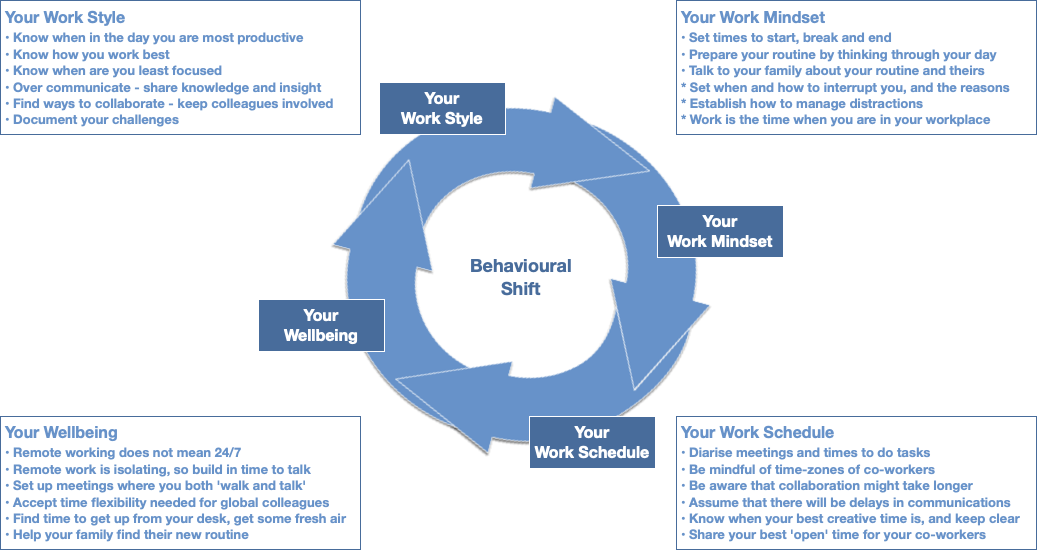An Individual's Guide to Working Remotely
Working at home all of the time is a lot different from staying in one day to receive a delivery. It requires some behavioural shifts, but once you realise what needs to change, you'll feel more confident.

So... you've suddenly found yourself working at home 5-days a week, and realised that it's more different than you thought it would be, especially because you've worked at home on occasion before, and matters have changed since then. Before we get deeper in the mysteries of coping with remote work, lets get the hygiene factors out of the way.
The basics
Set up your workspace. Find a space in your home where you can concentrate, ideally one where you can shut a door. Make sure that you have a powersocket nearby and enough space to set out your papers. It may be that you were able to bring home a second screen, so set up your working environment in line with Health and Safety guidance, particulary taking care to choose your chair and maintain your posture. It's good practice to rest your eyes by looking into middle and far distance from time to time, so, if you can, position yourself near a window. Now that we are all using Teams or Zoom, take a moment to consider the angle at which your image is seen by others. If necessary, put your laptop on a box to raise its height during calls. Don't forget to consider the background either. A potplant on the mantlepiece may appear to be growing out of your head, or the sun may create a halo behind you. An alternate background or blur in Teams or Zoom can help, but only if you sit very still.
Set your work pattern. Your rhythm of work may change when not in the office, so time time to think about your new routine. Balancing work and childcare at the same time may mean that you start earlier and finish later but take a couple of lengthty breaks. That's fine, but let your colleagues know your likely work pattern, and indicate your availability on your digital collaboration tools.
Compartmentalise work. Without the normal workday signals, like a commute, it can be harder to unwind. Make sure to take breaks, take on fluids and consciously stop work and 'go home' at the end of the day.
Embrace new technology. It can take a while to get used to seeing yourself on video, but that becomes easier the more you do it. Make sure all regular meetings are held by video call, so that all participants feel included and connected. Troubleshoot any difficulties joining video calls, by making sure that participants have the desktop version downloaded to their PC/Mac, and that they know the join PIN. Find time to have a play with your new tools and to understand the millennial minsdet that gets the most out of them.
Be mindful and inclusive. Your main interaction with co-workers will be by youfr digital tools and face-top-face in video meetings. A crowded conference call can make it difficult for people to share their opinions. Pause frequently to allow time for questions and remind attendees that they can use the chat window to share their thoughts. Take time to have 1-1 video calls with colleagues and stakeholders to retain the familiarity you had in the office.
Make up for missing informal chat. The quick chat by the coffee machine or at the water cooler is the glue in many organisations. People miss it when working remotely. Take time to have 1-1 video calls with colleagues and stakeholders to retain the familiarity that you had in the office.
Engage with teammates. Isolation is one of the biggest challenges of remote work, so create opportunities for the whole team to virtually get together. This can be daily coffee informal, a regular status check or an ideatiin session. Use the features in your digital tools to bring the meeting to life - sharing a personal photo or whiteboarding an idea.
Trust. We're in this together, so cut your colleagues some slack if they seem off-colour or out of sorts. We won't have the mutual insight that we get when sitting next to each other in the office, so we won't be privy to each others' hopes and fears. Think about your manager too, and the stress that they may be under in adapting to lead a remote team, and supposing - wrongly - that you're all skiving off. You must have trust and earn it, and it can grow. This is work, so ask for or set outputs, measures, responsibilities etc to show that you've adapted.
The benefits. There are many advantage to working at home:
- No loss of time to a commute
- Less time frittered away in idle chat
- No need to iron 5 shirts a week
- No dents in your car at the railway station
- More opportunities to balance work and home life.
so... keep smiling!
Behavioural Shifts
Your work style and work schedule will need to adapt when working remotely, and you'll need to take care of your mindset and wellbeing. These behavioural shifts can be unsettling, but you can take some comfort that many others in a similar position, and there is plenty of help available if you need it.

